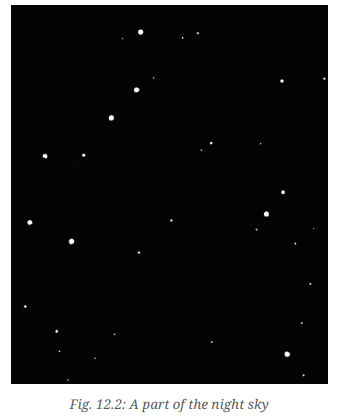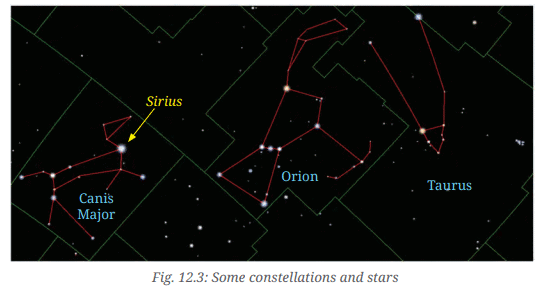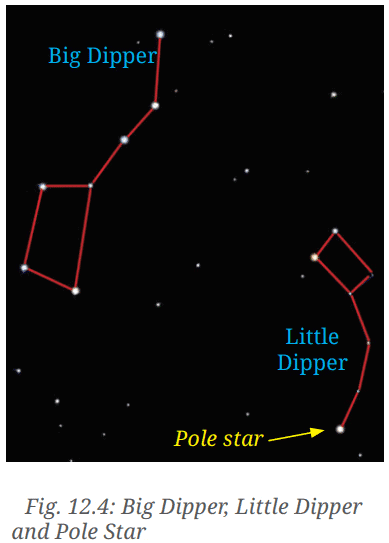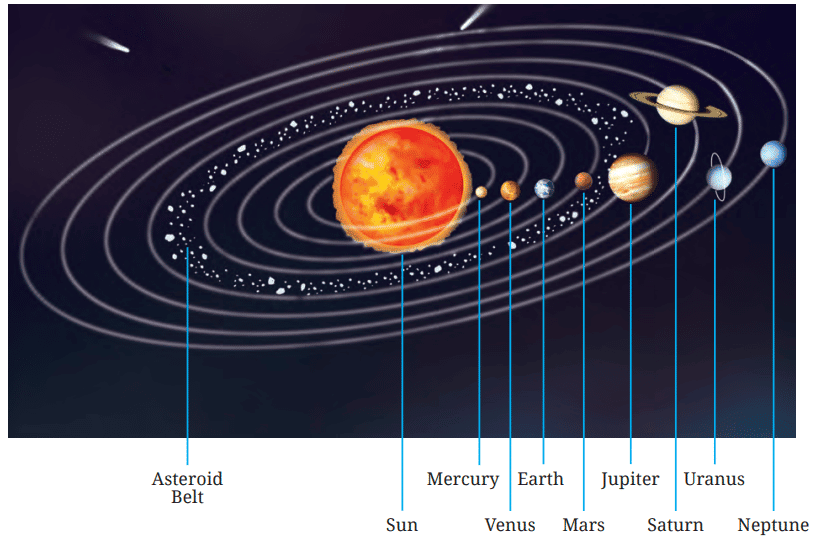Diagram Based Questions: Beyond Earth | Science Olympiad Class 6 PDF Download
Q.1: Answer the following questions based on the diagram given below:
(i) How does the arrangement of stars in Fig. 12.2 differ from random stars in the sky?
(ii) Why are imaginary lines drawn between the stars in the diagram?
(iii) What kind of pattern might the stars in Fig. 12.2 resemble after connecting them?
(iv) Why do different people create different patterns from the same group of stars?
Ans:
(i) The stars in Fig. 12.2 are a specific group that can form recognizable patterns, unlike random stars scattered across the sky.
(ii) Imaginary lines are drawn to connect stars to form patterns resembling familiar objects or animals for easy identification.
(iii) The stars might resemble an animal or object, such as a hunter, boat, or cot, depending on imagination.
(iv) Different people create different patterns because they interpret the star arrangements based on their own imagination and cultural stories.
Q.2: Answer the following questions based on the diagram given below (Fig. 12.3):
(i) What characteristic of the night sky is being studied in the diagram?
(ii) What is the main difference between the red and green lines in Fig. 12.3?
(iii) Why is Orion represented as a hunter in the diagram?
(iv) How does the position of Sirius in relation to Orion help in identifying it?
(v) Why are constellations like Orion useful for navigation?
Ans:
(i) The diagram studies the patterns formed by groups of stars, known as constellations.
(ii) Red lines show the star patterns forming the constellation, while green lines indicate the defined regions of the sky.
(iii) Orion is represented as a hunter because its star pattern, including three stars forming a belt, resembles a human figure.
(iv) Sirius is located along an imaginary line through Orion’s three middle stars towards the east, making it easier to find.
(v) Constellations like Orion help in navigation by providing recognizable patterns to determine directions at night.
Q.3: Answer the following questions based on the diagram given below (Fig. 12.4):
(i) What is the main focus of the diagram?
(ii) How do the Big Dipper and Little Dipper differ in the diagram?
(iii) Why does the Pole Star appear stationary in the diagram?
(iv) How can the Big Dipper help locate the Pole Star in Fig. 12.4?
(v) Why are the lines in the diagram not visible in the actual night sky?
Ans:
(i) The diagram focuses on identifying the Big Dipper, Little Dipper, and Pole Star in the night sky.
(ii) The Big Dipper is larger and part of Ursa Major, while the Little Dipper is smaller and part of Ursa Minor.
(iii) The Pole Star appears stationary because it is aligned with Earth’s rotational axis in the Northern Hemisphere.
(iv) The Big Dipper’s two end stars point to the Pole Star, located about five times their distance towards the north.
(v) The lines are imaginary, drawn only for identification, and not visible in the actual night sky.
Q.4: Answer the following questions based on the diagram given below (Fig. 12.7):
(i) What does the diagram represent?
(ii) How do the inner planets differ from the outer planets in the diagram?
(iii) Why is the asteroid belt shown between Mars and Jupiter?
(iv) How does the Sun’s position in Fig. 12.7 affect the objects around it?
(v) Why are the sizes and distances in the diagram not to scale?
Ans:
(i) The diagram represents an artist’s view of the Solar System, including the Sun, planets, and other objects.
(ii) Inner planets (Mercury, Venus, Earth, Mars) are smaller and rocky, while outer planets (Jupiter, Saturn, Uranus, Neptune) are larger and gaseous.
(iii) The asteroid belt is shown between Mars and Jupiter because it is the region where many asteroids orbit the Sun.
(iv) The Sun’s central position causes planets, asteroids, and comets to revolve around it due to its gravitational pull.
(v) Sizes and distances are not to scale to fit all objects on the page, as actual distances are vast.
|
70 videos|150 docs|104 tests
|
FAQs on Diagram Based Questions: Beyond Earth - Science Olympiad Class 6
| 1. What are the main differences between the terrestrial planets and gas giants in our solar system? |  |
| 2. How do scientists explore space beyond Earth? |  |
| 3. What are some potential benefits of exploring beyond Earth? |  |
| 4. What are the challenges faced in space exploration? |  |
| 5. How can space exploration help us understand climate change on Earth? |  |
















